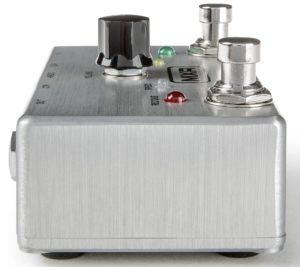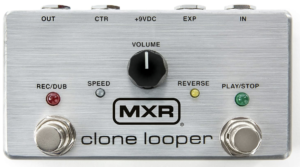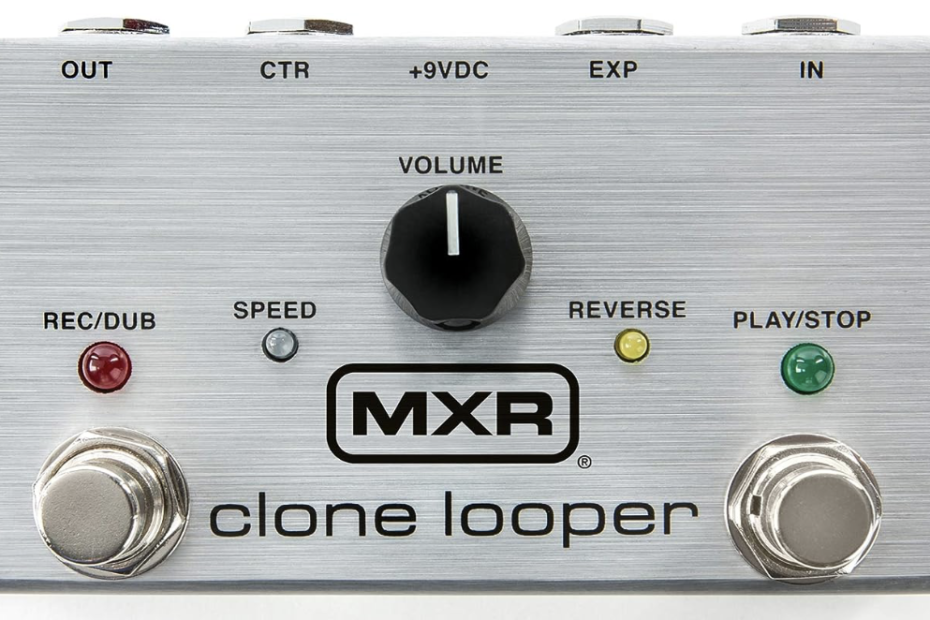MXR Clone Looper Guitar Effects Pedal is a looping pedal offered by MXR, a well-known manufacturer of guitar effects pedals. The Clone Looper is designed to provide guitarists with a versatile and easy-to-use looper for creating loops, layering sounds, and enhancing their live performances.
Looping Capabilities
 The MXR Clone Looper [link] allows guitarists to record and layer loops, enabling them to create backing tracks, add textures to their playing, and experiment with live soundscapes.
The MXR Clone Looper [link] allows guitarists to record and layer loops, enabling them to create backing tracks, add textures to their playing, and experiment with live soundscapes.
MXR is known for creating user-friendly pedals, and the Clone Looper is no exception. It typically features a straightforward and intuitive interface with minimal controls, making it easy to record, overdub, play, and stop loops during live performances.
The recording time of the Clone Looper may vary depending on the specific model or version. Some versions of this pedal offer longer recording times than others. Be sure to check the product specifications for the exact recording time available on the model you’re interested in.
Undo/Redo Functionality
Many looping pedals, including the MXR Clone Looper, include an undo/redo function. This allows you to quickly erase the last layer you recorded if you made a mistake and then redo it if needed.
True bypass switching ensures that the pedal doesn’t color your guitar tone when it’s not actively engaged. This is important for maintaining the integrity of your sound when the looper is bypassed.
MXR is known for its rugged and durable pedal enclosures, and the Clone Looper is typically built to withstand the rigors of live performance and heavy stomping.
Also Read:
TC Electronic DITTO+ Looper Review
BOOMERANG III Phrase Sampler: Guitar Effects Looper Review
Playwell Drum Machine Looper Review
7 Best looper pedals for guitar
Nux Loop Core Pedal: The Looper To Rule All
Compatibility
 The MXR Clone Looper [link] is designed to work with electric guitars and basses. It can be used in conjunction with other pedals and effects to create complex and layered sounds.
The MXR Clone Looper [link] is designed to work with electric guitars and basses. It can be used in conjunction with other pedals and effects to create complex and layered sounds.
Like most pedals, the MXR Clone Looper usually requires a standard 9-volt DC power supply for operation. Ensure that you have a suitable power source available.
LEDs on the pedal typically provide visual feedback, indicating when you are recording, overdubbing, or playing back a loop.
Stereo Input/Output (Depending on Model): Some versions of the MXR Clone Looper may offer stereo input and output options, allowing for greater sonic versatility when used with stereo setups or multi-amp configurations.
Using This Pedal
Using the MXR Clone Looper Guitar Effects Pedal is generally straightforward. Below are the steps you need to follow for using a looper pedal like the MXR Clone Looper:
- Setup:
- Connect your guitar to the input of the Clone Looper pedal.
- Connect the output of the pedal to your amplifier or the next pedal in your signal chain.
- Power the pedal using a suitable 9-volt DC power supply.
- Basic Controls:
- The MXR Clone Looper features a minimalistic control layout, including:
- Footswitch: This is the large switch on the pedal. Press it to start recording a loop, press it again to overdub additional layers, and press it once more to stop playback. You may need to refer to the pedal’s documentation or labeling for specific footswitch functions.
- Level (Mix): This knob controls the balance between the looped sound and your dry (unaffected) signal. Adjust it to blend the looped sound with your live playing.
- The MXR Clone Looper features a minimalistic control layout, including:
- Recording a Loop:
- To record a loop, start by engaging the pedal by pressing the footswitch. The LED indicator(s) on the pedal will typically change color or flash to indicate that recording is active.
- Play your guitar part, and the pedal will capture and loop that part.
- When you want to end the loop, press the footswitch again. The LED indicator(s) will typically change to indicate that the loop is now playing.
- Overdubbing:
- After recording a loop, you can overdub additional layers on top of it to build complexity. To overdub, press the footswitch while the loop is playing.
- You can continue to overdub as many layers as you like until you achieve the desired sound.
- Stopping and Clearing the Loop:
- To stop playback and clear the loop, press the footswitch again when the loop is playing. The pedal should stop and reset to an empty loop.
- Undo/Redo (if available):
- Some looper pedals, including the MXR Clone Looper, may have an undo/redo function. Check the pedal’s documentation to see if this feature is available and how to use it. It typically involves holding down the footswitch for a specific amount of time.
- Experiment and Practice:
- Loopers are excellent tools for experimenting with different musical ideas, practicing scales or solos, and creating layered compositions. Take your time to explore the creative possibilities.
- End of Performance:
- When you’re done with your performance or practice session, make sure to disengage the pedal (bypass it) using the footswitch to return to your unaffected guitar signal.
- Saving and Reusing Loops (if available):
- Some looper pedals offer the ability to save and store loops for later use. If your Clone Looper has this feature, consult the user manual for instructions on how to save and recall loops.
The MXR Clone Looper is designed to be a versatile and user-friendly tool for musicians looking to incorporate looping into their performances or practice routines.
Competitors
 Here is a list of competitors to the MXR Clone Looper:
Here is a list of competitors to the MXR Clone Looper:
- BOSS RC-3 Loop Station:
- The BOSS RC-3 is a popular compact looper pedal known for its versatility, including up to 3 hours of stereo recording time, built-in drum patterns, and USB connectivity for importing and exporting loops.
- TC Electronic Ditto Looper Series:
- TC Electronic’s Ditto series includes a range of loopers, such as the Ditto Looper, Ditto X2, and Ditto+ (the most recent version). These pedals are known for their simplicity, great sound quality, and compact design.
- Electro-Harmonix Nano Looper 360:
- Electro-Harmonix offers the Nano Looper 360, a compact looper pedal with 360 seconds (6 minutes) of recording time, making it suitable for longer loops and complex compositions.
- Digitech JamMan Solo XT:
- The Digitech JamMan Solo XT offers a variety of features, including 35 minutes of stereo loop recording, built-in drum loops, and the ability to expand memory with an SD card.
 Pigtronix Infinity Looper:
Pigtronix Infinity Looper:- The Pigtronix Infinity Looper is a high-end looper pedal with advanced features like two stereo loops, MIDI sync, reverse and octave effects, and more.
- EHX 720 Stereo Looper:
- Another offering from Electro-Harmonix, the 720 Stereo Looper provides 12 minutes of high-quality, stereo recording time, and it includes 10 independent loops and a built-in metronome.
- DigiTech Trio+ Band Creator + Looper:
- The Trio+ pedal combines a looper with a band creator, allowing you to create backing tracks on the fly. It can analyze your playing and generate bass and drum parts to accompany your guitar.
 NUX Loop Core Deluxe:
NUX Loop Core Deluxe:- The NUX Loop Core Deluxe offers up to 8 hours of recording time, drum patterns, and the ability to save and load loops using a micro SD card.
- Donner Tiny Looper:
- Donner offers a budget-friendly option with their Tiny Looper pedal, providing up to 10 minutes of loop time in a compact form factor.
- EHX 22500 Dual Stereo Looper:
- Another Electro-Harmonix offering, the 22500 Dual Stereo Looper, features two stereo loops, a robust foot controller, and extensive looping capabilities.
